This was published 4 years ago
'A racist monument': Fresh battle looms over Trump's border wall
A passionate community is suing the President over his policy, showing that the border is never settled between the US and Mexico.
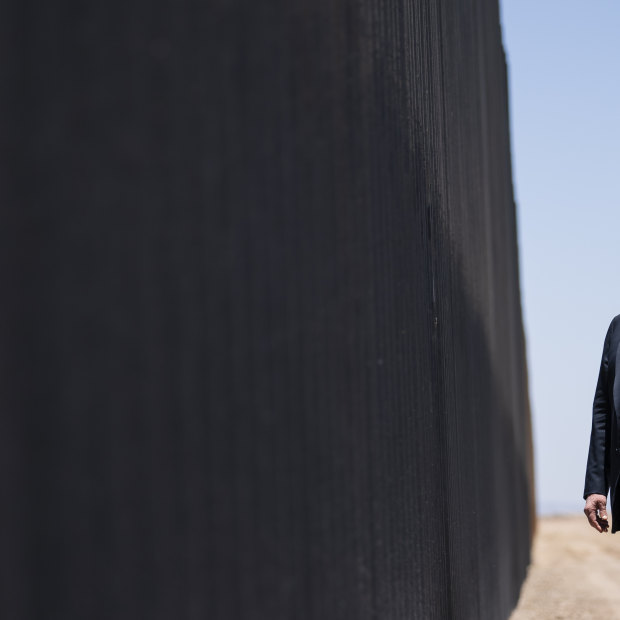
Donald Trump tours a section of the Mexican border wall in Arizona on June 23. Credit: AP
It’s shortly after 6pm as the sunset dips its golden light over the Rio Grande river that separates the United States from Mexico.
For centuries, this border has been the flashpoint of fractious dispute.
America and Mexico waged a two-year war over it in the 1840s. Geronimo led the Apache raids across the river to strike US and Mexican settlers alike. Bootleggers and later drug dealers used the region to help ply their trade. Then, Donald Trump decided that the border needed a “big, beautiful wall” to curtail America’s southern neighbour.
Now, a passionate Texan community is suing the US President over his policy, showing that the border is never settled.
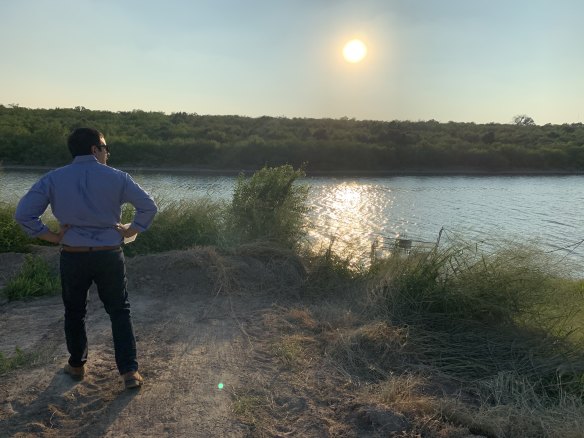
Laredo resident and lawyer Carlos Flores overlooking the Rio Grande river.Credit: Farrah Tomazin
“We don’t want his racist monument,” says Carlos Flores, a South Texan lawyer who has filed a lawsuit against the wall on behalf of landowners and the Zapata County local government.
“A border wall here will destroy the environment, it will involve seizing thousands of acres of land that belongs to people, and it will potentially impact our main source of drinking water: the Rio Grande. The one thing standing in his way is our sleepy little community.”
It’s a scorching summer day in the Lone Star State, and Flores is standing on the water’s edge, gazing quietly at the grasslands in the distance.
Behind him is San Ygnacio, a historic settlement dotted with sandstone forts, heritage houses and an old Spanish church.
To his right is a tranquil bird sanctuary, where white-collared seedeaters breed in the marshland along the riverfront.
And 48 kilometres to the north is his hometown of Laredo, a thriving regional city with a population of 265,000, most of whom are Mexican-Americans.
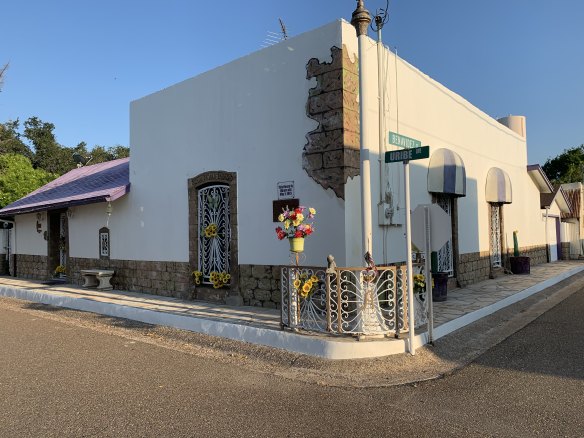
A historic home in San Ygnacio that is set to be affected if a border wall is built.Credit: Farrah Tomazin
All three sites are now at the centre of this David-and-Goliath battle over one of Trump’s most incendiary policies.
It was June 2015 when Trump announced his candidacy for president, insisting he would build a wall along the US-Mexico border to thwart the flow of illegal immigrants and narcotics into America.
“Mark my words,” he said at the time, “I will build a great, great wall on the Mexican border, and I will have Mexico pay for that wall.”
Five years later, the rhetoric often struggles to match the reality. The United States-Mexico border spans about 3145 kilometres, and about a third of it contains walls erected by successive governments over several decades.
Today, most of the barriers Trump claims to have built have merely replaced fencing that was previously installed by his predecessors. Furthermore, Americans - not Mexicans - are footing the bill.
And last month, Trump’s former adviser, Steve Bannon, was charged with fraud for allegedly fleecing thousands of well-meaning donors through a shonky online fundraiser and company known as “We Build the Wall”.
But even as the wall was gradually constructed over the years, Laredo and its citizens had largely been left untouched — until now.
If the Trump administration gets its way, residents face the prospect of a nine-metre steel and concrete wall stretching for 111 kilometres across Webb and Zapata counties, where no barriers previously existed.
Not surprisingly, many locals are furious. Some are now taking the matter to court, suing Trump on the grounds of racial discrimination.
“Time and again President Trump speaks of immigrants, Mexicans, Mexican Americans and people from the border as criminals and dehumanises them in order to justify the construction of a border wall,” says the lawsuit filed by Flores on behalf of Zapata County and two local landowners.

An untouched section of the Rio Grande river, which separates the US from Mexico.Credit: Farrah Tomazin
“Like other communities of colour, who have suffered comparable or worse injustice(s) at the hands of the United States government, the Plaintiffs seek refuge in the Fifth Amendment to the United States Constitution on multiple grounds.”
Boiled down, the lawsuit argues that Trump’s policy effectively creates a “second class” of US citizen who can have their land seized by the government based on “white nationalist motives”.
As such, the plaintiffs say, it violates the constitution, which is meant to provide due process and equal protection under the law.
The sentiments are shared by many of the South Texan residents and business owners who spoke last week as the election campaign kicked into gear.
Opponents believe the wall would do little to stem the tide of narcotics from Mexico, much of which are smuggled in vehicles through legal ports of entry.
There’s also the risk to the Rio Grande itself, an iconic waterway covering three US states — Colorado, New Mexico, and Texas.
As the fifth longest river system in North America, the basin is both a wildlife corridor for deer, cattle and horses, and a lifeblood for the communities surrounding it.
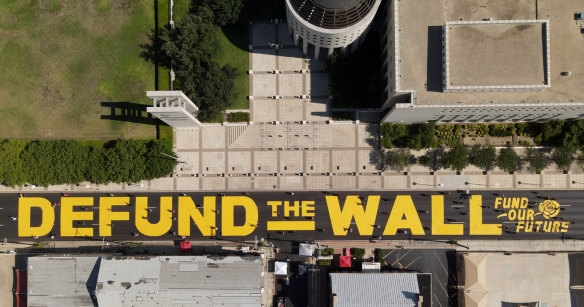
An aerial shot of a new "Defund The Wall" mural that was painted outside the Laredo federal courthouse.
Laredo is not usually an activist city, but locals feel so passionately about this issue some have now joined a grassroots group, the No Border Wall Coalition, in a bid to gather strength. Last month, they painted a massive street mural, inspired by the Black Lives Matter movement.
The words “Defund The Wall” now stretch across the entire length of Laredo’s federal courthouse.
“This is a place where I want my kids to raise their own children," says Melissa Cigarroa, who is one of the two key landowners fighting the wall in court. "But how are they going to do that if their community has been defiled by this monstrosity?”
Cigarroa says the government’s motives became clear at a briefing in February, where Customs and Border Protection officials and the US Attorney's Office outlined their plan to local landowners.
Officials at the meeting explained that the Trump administration had extraordinary powers to push ahead with the wall after a series of environmental laws were waived to fast-track construction.
They even showed her a map, with a cross-section of the area where they wanted the right of entry to her riverside property, which spans about 173 acres, and tried to get her to sign it over immediately.
“That’s when I lost it,” says Cigarroa, the board president of the Rio Grande International Study Centre. “There's been no consideration for how this wall impacts people's lives.”
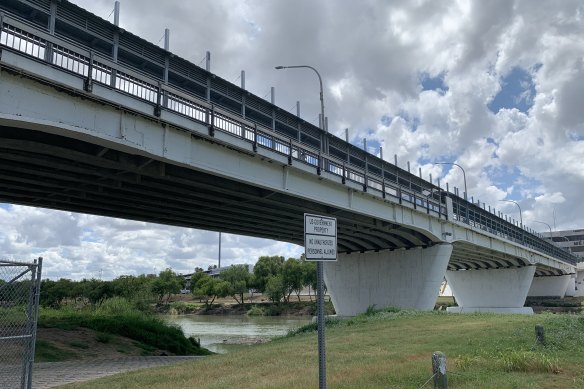
The main river crossing connecting the South Texan city of Laredo to Mexico.Credit: Farrah Tomazin
The issue has clearly divided South Texas. Earlier this year, local Border Patrol union boss Hector Garza founded the “Laredo Trump Train” Facebook group for people who support the wall, but felt that “conservative voices” like his were being drowned out in the debate.
On September 12, the group plans to hold a peaceful demonstration in support of the President and his policies. Part of it will involve driving over the mural outside the federal courthouse.
Laredo’s Customs and Border Protection chief patrol agent, Matt Hudak, is also a staunch defender.
Hudak did not respond in time for deadline, but in a tweet this week, he insisted the wall “is making both sides of the border safer and denying cartels the ability to profit from the border”.
Hudak also put out a press release this week, noted that border patrol agents had managed to stop a human smuggling attempt at a checkpoint on Interstate 35, north of Laredo. Fifty-two people were discovered hidden in a trailer, including foreign nationals from Mexico, Honduras, Ecuador and Guatemala.
Zapata County council member Mercurio Martinez doesn’t doubt that there are sections of the community that support a steel barrier being built. Nor does he deny that some parts of America “might need a wall” such as areas between El Paso and California, which aren’t delineated by a river.
But he believes that other measures could be just as effective and cost far less, such as more “boots on the ground” and additional sensors and drones to weed out people trying to cross into the US illegally.
For someone like Martinez, who owns a riverside ranch that he rents out to recreational hunters for supplementary income, this is as much about his history and livelihood as it is about his community.
“I trace my family on my father’s side back to 1540, so when we talk about ranch land, we’re talking about generations of ownership,” he says.
“We’ve tried to negotiate an alternative outcome — and I’ve spent many a time in Washington DC or on the phone with government officials. But it was clear to us that it didn’t matter what we thought, because the President has made a campaign promise and they’re determined to push ahead with it.”
Back in San Ygnacio, Carlos Flores is equally determined to stop them. As we tour the Rio Grande, a Border Patrol vehicle drives past to survey the area, followed soon after by a low flying patrol helicopter zigzagging along the highway.
Flores knows the community faces an uphill battle to fend off the wall, but he’s optimistic, too, that their legal case is a strong one.
The lawsuit — which the Trump administration must respond to by September 15 — directly names the President, along with the Department of Homeland Security Acting Secretary Chad Wolf and the head of Customs and Border Protection, Mark Morgan, as key defendants.
It also uses the President’s own words against him, citing in detail many of the inflammatory tweets and comments Trump has made to justify the wall, such as Mexicans being “bad hombres”, “murderers” or “rapists”.
If successful, the case should significantly alter southern border politics for years to come —regardless of who wins the White House in November.
“Now,” says Flores, “it’s up to the courts to decide.”
Are you a dual citizen living in the United States? We'd like to hear from you.
The Sydney Morning Herald and The Age would like to talk with dual citizens about the US election campaign and how they intend to vote. You can contact us at a.mcguire@smh.com.au